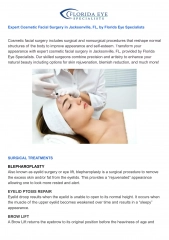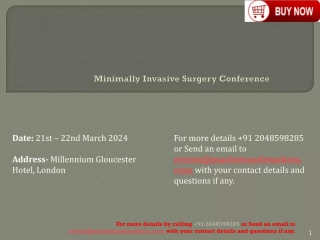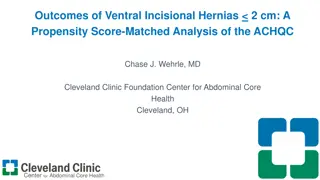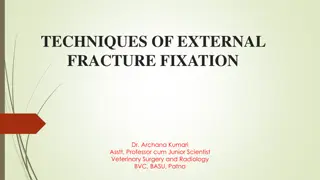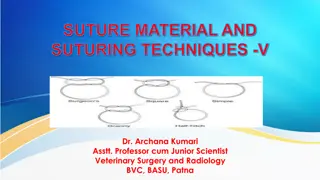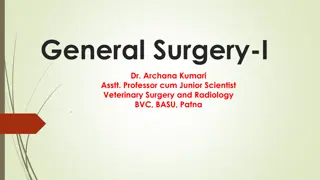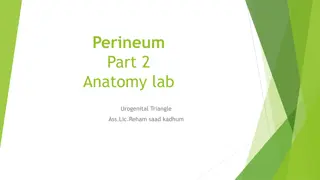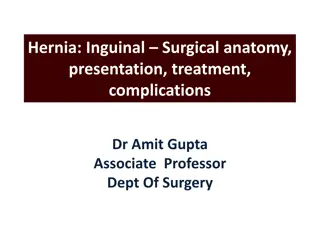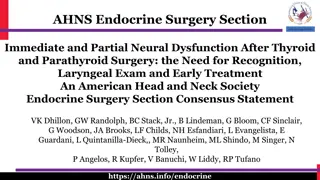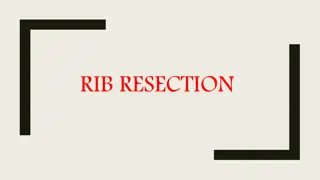Understanding Perineal Hernias in Veterinary Surgery
Perineal hernias are a common condition in uncastrated males but can also occur in females and cats. Weakness in the pelvic diaphragm can lead to herniation due to factors like hormonal disorders, prostatic diseases, and rectal issues. The symptoms include swelling in the perineal region, and diagnosis is based on clinical signs and history. Treatment options range from traditional herniorrhaphy to internal obturator transposition herniorrhaphy. Proper diagnosis and management are essential to prevent complications and ensure the well-being of the animal.
Download Presentation

Please find below an Image/Link to download the presentation.
The content on the website is provided AS IS for your information and personal use only. It may not be sold, licensed, or shared on other websites without obtaining consent from the author. Download presentation by click this link. If you encounter any issues during the download, it is possible that the publisher has removed the file from their server.
E N D
Presentation Transcript
HERNIAS PART II GULSHAN KUMAR DEPT. OF VETERINARY SURGERY & RADIOLOGY COLLEGE OF VETERINARY SCIENCE AND ANIMAL HUSBANDRY U.P. PT. DEEN DAYAL UPADHYAYA PASHUCHIKITSA VIGYAN VISHWAVIDYALAYA EVAM GO ANUSANDHAN SANSTHAN, MATHURA- 281 001
PERINEAL HERNIA Most common in uncastrated males, however it has also been reported in females and cat, though rarely. Weakening of the pelvic diaphragm; hernia can occur due to the following factors: Hormonal disorders, Prostatic diseases, Rectal diseases and Anatomical factors rectal deviations, diverticula etc.
PERINEAL HERNIA: SYMPTOMS A unilateral or bilateral swelling (Fluctuating/hard) ventral and lateral to the anus (in the ischiorectal fossa) in the perineal region. The hernial contents are usually rectum, enlarged prostate and perineal fat, retroflexed bladder and uterus in case of females. Incarceration of bladder in the perineal hernia should be considered an emergency. Should be differentiated from perineal neoplasms.
PERINEAL HERNIA: DIAGNOSIS On the basis of clinical signs and history. Gentle pressure over the swelling will reduce the contents if adhesions have not occurred. Contrast radiography with barium enema will help to differentiate rectal deviation from rectal diverticulum. Ultrasonography can be used to identify a retroflexed bladder.
PERINEAL HERNIA: DIAGNOSIS The pelvic diaphragm: 1. M. levator ani 2. Coccygeal muscle 3. Superficial gluteal muscle 4. External anal sphincter muscle 5. Internal obturator muscle Arrows A and B show the sites of herniation.
PERINEAL HERNIA: TREATMENT 1. Traditional (Anatomic) Herniorrhaphy Preplace simple interrupted 0 or 2-0 monofilament sutures using a large, curved needle Begin suture placement between the external anal sphincter and the levator ani, coccygeus, or both muscles. Space sutures less than 1 cm apart. As placement progresses ventrally and laterally, incorporate the sacrotuberous ligament for a secure repair if necessary.
PERINEAL HERNIA: TREATMENT 2. Internal Obturator Transposition Herniorrhaphy Separate the origin of the internal obturator muscle from the ischial tuber. Elevate the periosteum and internal obturator muscle from the ischium to form a flap. Transpose this flap dorsomedially into the defect to allow apposition between the coccygeus, levatorani, and external anal sphincter.
PERINEAL HERNIA: TREATMENT 2. Internal Obturator Transposition Herniorrhaphy Preplace simple interrupted sutures the same as with the traditional technique. Begin by apposing the combined levator ani and coccygeus muscles with the external anal sphincter muscle dorsally. Then place sutures between the internal obturator and external anal sphincter medially and the levator ani and coccygeus muscles laterally.
GUT TIE Common in bullocks, rarely in others. When a portion of intestine passes through and gets entangled in a tear in the fold of serous membrane suspending the spermatic cord in the sub lumbar region or in a hernial ring like slit/ring formed between adhesion of the cut end of the spermatic cord to the abdominal wall and the lateral abdominal wall. The incised end of the spermatic cord retracts in to the abdominal cavity and adheres/heals to the abdominal wall forming a ring/slit. A loop of bowels may pass through it and gets trapped preventing the function of the bowel. Seen only on the right side as the rumen on the left side prevents its occurrence on the left.
GUT TIE: DIAGNOSIS Pain on palpation on the right flank. Rectal examination wherein the distended and herniated portion of the bowels and the stretched spermatic cord can be palpated.
GUT TIE: TREATMENT Sometimes it resolves on its own when the animal jumps from a height or walks down rapidly. Attempts may be made to reduce the hernia by rectal manipulation Right flank laparotomy may be done to reduce the hernia.
DIAPHRAGMATIC HERNIA- DOGS The congenital form is peritoneo-pericardial diaphragmatic hernia. Signs become apparent when the animal shifts to solid food or may be noticed incidentally on a thoracic radiograph or necropsy. Acquired diaphragmatic hernia is usually traumatic leading to protrusion of omentum, stomach/liver or rarely, intestines into the thoracic cavity. The extent of herniation depends upon size and location of tear. Gradually develops through a small tear due to negative pressure in the thoracic cavity and bellowing action of the abdomen during respiration. Weakest points in the diaphragm are Close to posterior vena cava, Costal margin, and close to the oesophagus.
DIAPHRAGMATIC HERNIA- SIGNS May not be noticed until the 6 months of age when starts feeding on solid foods. Abdominal respiration, peculiar easily, unthrift and tucked up abdomen. Tendency to vomit after feeding, reluctance to move. Remains in standing position or sits on the hunches. Difficulty and pain while walking down from a height. Chronic stomach disorders, respiratory distress, gurgling sounds on auscultation of chest. Absence of respiratory sounds on affected side. More pronounced respiratory distress immediately after feeding. cough, tendency to tire
DIAPHRAGMATIC HERNIA- DIAGNOSIS On the basis of history, signs, auscultation (muffled heart sounds). Radiography (Survey and contrast), Ultrasonography Exploratory laparotomy.
DIAPHRAGMATIC HERNIA- TREATMENT Only surgical treatment is possible. The diaphragm may be approached by: Abdominal approach, Lateral thoracic approach, Median sternotomy and rib splitting are rarely used, In all approaches, positive pressure ventilation is required. Restore the negative pressure in the thorax before final closure.
DIAPHRAGMATIC HERNIA- TREATMENT Thoracic approach: Entered through 6th or 7th intercostal space. The hernia is reduced and the tear in the diaphragm is sutured with a 1-0 synthetic absorbable suture material. Avoid injury to lungs and other great vessels. The intercostal incision is closed including the adjacent ribs. Abdominal approach: Mid line incision starting from Xyphoid backwards is made. The hernia is reduced and the tear in the diaphragm is closed in the same manner.
DIAPHRAGMATIC HERNIA- BOVINE In cattle and buffaloes, reticulum is the common herniating organ, however the omasum, abomasum, loops of intestine, spleen or liver may also get involved. Weakening of the diaphragm by lesions of traumatic reticulo peritonitis, congenital weak points of the diaphragm and physical force like increased intra abdominal pressure during pregnancy and parturition, or a violent fall.
DIAPHRAGMATIC HERNIA- SIGNS Recurrent tympany not responding to medical treatment. The tympany is mild if only a small portion of reticulum is herniated. Progressively, the signs became severe due to development of adhesions between the reticulum and other structures like lungs, pericardium, thoracic wall and hernial ring. Complete or partial cessation of milk, scanty, foul smelling pasty faeces, a degree of melaena, regurgitation may lead to aspiration pneumonia. Brisket oedema and jugular pulse, abduction of fore limbs, rarely chronic cough may be present. Muffled cardiac sounds and reticular sounds heard cranial to the 6thrib. If untreated cases, inanition, progressive emaciation, weakness and dehydration leading to death. The diagnosis is confirmed by plain and contrast radiography. Left flank exploratory laparotomy may be done.
DIAPHRAGMATIC HERNIA- TREATMENT Only surgical treatment is effective. 1. Rumenotomy to evacuate the contents of the rumen and reticulum followed by cud transplantation. 2. Administer I/v fluids for 48 hours and thereafter the soft diets with fluids, surgery to correct hernia may be delayed for 3-4 days. 3. The common approaches for surgery are abdominal and thoracic. Irrespective of the approach, proper ruminal evacuation and assisted ventilation during herniorrhaphy are required for successful procedure.
INGUINAL HERNIA Also called Bubonocele, it is protrusion of an abdominal organ through the inguinal canal. If the hernial contents extend into the scrotum in male animals the condition is called as scrotal hernia . Incidence: Bitches, horses, bulls and pigs. Anatomy: the passage through which- the contents of spermatic cord in males, or the round ligament in females pass, is an opening in the caudo-ventral abdominal wall termed the inguinal canal which is slit like, between the abdominal muscles connecting the internal and external inguinal rings.
INGUINAL HERNIA Inguinal hernias may be: -direct (through a rent in the body wall) or -indirect (through the already existing inguinal ring or umbilical ring).
INGUINAL HERNIA: SYMPTOMS In female dogs, appreciable swelling is noticed in the inguinal region, difficulty in defecation, In large animals swelling in the inguinal canal at the neck of scrotum, Unilaterally enlarged scrotum; affected bulls or stallions may be reluctant to serve, Refuse to move due to pain, Abduction of hind limbs Systemic signs are evident only when the hernia gets strangulated. Hernial contents may be intestines, urinary bladder, omentum or uterus in female. Diagnosis is based on clinical signs, palpation, radiography & USG
INGUINAL HERNIA: TREATMENT In small animals: A paramedian incision is made close to the inguinal swelling. The contents are reduced by gentle pressure. A kelotomy (extension of the hernial ring) may be performed if the hernial ring is small. Debride the edges and close with absorbable suture material by overlapping pattern. In large animals: Reduce the contents and close the tunica vaginalis with purse string suture as high as possible. Muscles & fascia closed with overlapping suture, the skin is closed in a routine manner.
OTHER HERNIAS Hiatal Hernia: A form of diaphragmatic hernia where the caudal end of the oesophagus and cardiac area of the stomach pass through the oesophageal hiatus of the diaphragm. The associated sign is the oesophagitis. Treatment consists of reducing the hernia and reconstructing the diaphragm. Gut Tie: Already discussed above.


